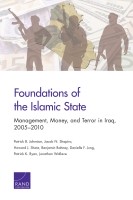| 来源类型 | Research Reports
|
| 规范类型 | 报告
|
| DOI | https://doi.org/10.7249/RR1192
|
| ISBN | 9780833091789
|
| 来源ID | RR-1192-DARPA
|
| Foundations of the Islamic State: Management, Money, and Terror in Iraq, 2005–2010 |
| Patrick B. Johnston; Jacob N. Shapiro; Howard J. Shatz; Benjamin Bahney; Danielle F. Jung; Patrick Ryan; Jonathan Wallace
|
| 发表日期 | 2016
|
| 出版年 | 2016
|
| 页码 | 348
|
| 语种 | 英语
|
| 结论 |
ISI Adopted a Vertically Integrated Bureaucratic Model- ISI's bureaucratic model looked like the ideal structure al-Qa'ida operatives described in memos, but ISI replicated that structure at local levels to implement territorial control.
- By 2008, ISI had subdivided Iraq into specific sectors but was struggling to fill its designated positions at the subnational level.
- ISI allocated human capital rationally, with the suicide-bomber corps dominated by foreigners (more likely than Iraqis to be fanatical believers in the group's ideology) and with intelligence and security personnel (where local knowledge was critical) dominated by its Iraqi members. However, the majority of foreign fighters were not suicide bombers.
- ISI's management and information reporting requirements appeared quite systematic for an ostensibly covert militant organization.
As with the Present-Day Islamic State, ISI Demonstrated Sophisticated Financial Management- The salaries and other compensation ISI paid to its members seem designed for an environment where labor was plentiful and the organization needed to attract loyal members and screen out opportunists and spies.
- ISI's monthly payroll consistently consumed the largest single portion of its revenues. ISI had a well-developed payroll system with clearly defined salaries.
- There was significant personnel mobility within ISI. Turnover was high, and the group frequently reassigned members to different military units or back-office positions.
- ISI aimed to raise money locally, largely from criminal activities but also partly from activities that resembled state action, such as taxation.
- ISI placed a premium on local fundraising because that gave it maximum control. Fundraising also allowed the group to look more like a state; its taxation activities resembled what any state might do.
- ISI leadership sought substantial oversight of the group's finances and put in place detailed record-keeping requirements for tracking and auditing purposes.
|
| 摘要 |
- Any counterpersonnel strategy against ISI must strive to eliminate entire layers of high-level and midlevel managers.
- Capitalizing on any fissures within the group will be essential to defeating the Islamic State and ensuring that the group does not reemerge.
- If the coalition can cause a cutoff of salaries, it could harm morale within, and support for, the Islamic State for a failure to deliver on promises made to recruits. This could be even more damaging if combined with evidence that some leaders were embezzling money.
- To broaden the fight against the Islamic State's revenues, the coalition will need to identify the intermediaries and end purchasers of the group's products and either target these people or sanction them and their financial institutions.
- The coalition has elevated efforts to interdict oil transport, including targeting oil infrastructure and trucks. Other measures could include destroying road entrances to oil fields and giving heightened attention to any oil trucks leaving the Islamic State territory. Any such truck must pass through checkpoints or border crossings and should be noticed or recorded, suggesting official complicity. Further investigation into how such trucks are able to get through checkpoints is merited and official complicity should be addressed.
- Stop the flow of foreign fighters in both directions: Enhance border controls in transit countries (Turkey, most especially); more effectively scrutinize potential members from source countries; stop people from getting first-hand training and becoming integrated directly into fighter facilitation networks; and improve information-sharing among intelligence and law-enforcement organizations, both within and across countries.
|
| 主题 | Al Qaida
; Counterterrorism
; Iraq
; The Islamic State (Terrorist Organization)
; Syria
; Terrorism Financing
|
| URL | https://www.rand.org/pubs/research_reports/RR1192.html
|
| 来源智库 | RAND Corporation (United States)
|
| 引用统计 |
|
| 资源类型 | 智库出版物
|
| 条目标识符 | http://119.78.100.153/handle/2XGU8XDN/108421
|
推荐引用方式
GB/T 7714 |
Patrick B. Johnston,Jacob N. Shapiro,Howard J. Shatz,等. Foundations of the Islamic State: Management, Money, and Terror in Iraq, 2005–2010. 2016.
|
|
文件名:
|
x1535050888945.jpg
|
|
格式:
|
JPEG
|

|
文件名:
|
RAND_RR1192.pdf
|
|
格式:
|
Adobe PDF
|
此文件暂不支持浏览
除非特别说明,本系统中所有内容都受版权保护,并保留所有权利。